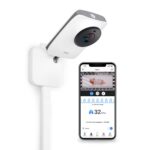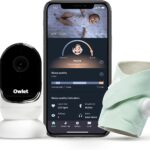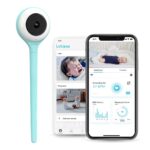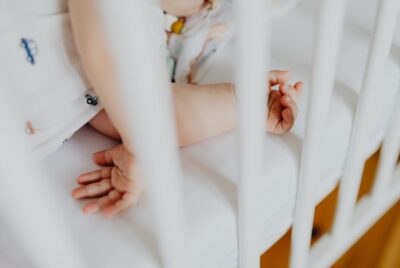Baby Oxygen Monitor
Every year, more than 3,000 babies in the U.S. die of sudden infant death syndrome (SIDS) and other causes that are unclear at first, including accidental suffocation or strangulation. The shock, grief, and guilt felt by families who lose an infant can be crushing. The American Academy of Pediatrics recommends a safe sleep environment to reduce the risk of all sleep-related deaths. New recommendations are presented regarding non inclined sleep surfaces, short-term emergency sleep locations, use of cardboard boxes as a sleep location, bed sharing, substance use, home cardiorespiratory monitors, and tummy time.
Being a parent comes with its fair share of worries and concerns, especially when it comes to the health and safety of your little one. For infants, monitoring their vital signs, such as oxygen levels, can provide crucial insights into their well-being. Baby oxygen monitors have emerged as valuable devices that help parents keep a close watch on their baby’s oxygen saturation levels.
In this article, we will explore the purpose, functionality, and benefits of baby oxygen monitors, as well as some considerations for choosing the right one.
What Does it Do
Baby oxygen monitors are non-invasive devices that typically consist of a small sensor placed on the baby’s foot or hand. The sensor uses infrared light to measure the oxygen saturation level in the blood and heart rate. 
Selecting the Right Baby Oxygen Monitor
- Accuracy and Reliability: Look for a baby oxygen monitor that provides consistent and precise readings. Check if the monitor has undergone clinical validation or meets industry standards.
- Comfort and Safety: Ensure that the monitor is designed with soft and hypoallergenic materials that won’t cause any discomfort or skin irritation. Look for monitors that have been specifically designed for infants, with features such as gentle sensors and adjustable straps.
- User-Friendly Features: Opt for a baby oxygen monitor that is user-friendly and easy to operate. Features like a clear and intuitive display, simple controls, and adjustable alarms are beneficial. A monitor with a bright and backlit display will allow you to check the readings easily, even in low light conditions.
- Alarm Functionality: Choose a monitor with adjustable alarm settings that alert you when oxygen levels fall below a certain threshold or if irregular readings are detected. Ensure that the alarm volume is sufficient to wake you up from sleep or grab your attention when needed.
- Battery Life and Power Options: Look for a monitor with a battery that lasts long enough to meet your monitoring needs. Check if the monitor comes with a low battery indicator or a power-saving mode to preserve battery life.
- Portability and Durability: Consider the monitor’s size, weight, and portability, especially if you plan to use it while traveling or on the go. Look for monitors with durable construction that can withstand accidental drops or bumps, ensuring longevity and reliability.
- Price and Warranty: Set a budget for the baby oxygen monitor and compare prices across different brands and models. While cost is a factor, prioritize the monitor’s quality and features over price alone. It’s also important to check the manufacturer’s warranty to ensure coverage in case of any defects or issues with the monitor.
Handpicked Selections for Our Valued Readers
Best Overall Baby Breathing Monitors
 Top 1 – Miku Pro Contact-Free Breathing & Sleep Tracking Monitor
Top 1 – Miku Pro Contact-Free Breathing & Sleep Tracking Monitor
The Miku Pro video baby monitor offers real-time monitoring of your baby’s RPMs (respirations per minute) through the Miku app on your smartphone. The monitor uses SensorFusion technology with multiple sensors for accurate data analysis. It provides real-time alerts for awake/asleep, movement, and sound. The monitor also features crystal clear 1080P HD video, night vision, two-way talk, and sensors for temperature, humidity, sound, and light in the nursery.
Shop Now
 Top 2 – Nanit Pro Complete Monitoring System
Top 2 – Nanit Pro Complete Monitoring System
It offers 1080p HD video via the app, unique Split Screen for two-camera viewing, and an Alert Zone for child safety. The Flex Stand provides versatile placement options. Nanit monitors sleep patterns, offering expert tips, real-time alerts, and one year of free Insights analytics. The Breathing Wear enables sensor-free breathing monitoring. HSA/FSA eligible.
Shop Now
 Top 3 – Sense U Smart Baby Monitor
Top 3 – Sense U Smart Baby Monitor
The Sense-U Video + Movement Smart Baby Monitor 3 offers comprehensive monitoring for your child’s sleep with features like abdominal movement tracking, feeling temperature, and sleep position indicators. The monitor also sends real-time notifications for slow abdominal movement and detects motions and sounds. It also supports twins.
Shop Now
Best Budget Breathing Monitor – Levana Oma Sense Baby Abdominal Movement Monitor
 Oma Sense baby monitor offers peace of mind with patented Wakeup Technology, gently stimulating babies if no abdominal movement is detected for 15 seconds. It doesn’t require skin contact and audibly alerts caregivers if movement isn’t re-established within 5 seconds. It’s suitable for newborns up to 6 months old. It operates without WiFi, radio, or Bluetooth frequencies.
Oma Sense baby monitor offers peace of mind with patented Wakeup Technology, gently stimulating babies if no abdominal movement is detected for 15 seconds. It doesn’t require skin contact and audibly alerts caregivers if movement isn’t re-established within 5 seconds. It’s suitable for newborns up to 6 months old. It operates without WiFi, radio, or Bluetooth frequencies.
Shop Now
Best in Design Breathing Monitor – Owlet Dream Duo Smart Baby Monitor
 Introducing the Dream Sock, a baby sleep tracker that monitors various sleep metrics, including wakings, heart rate, sleep quality, and total hours slept. Parents can access Owlet’s personalized sleep program for babies aged 4-12 months. The device provides a breakdown of each sleep session, allowing parents to spot patterns and make necessary schedule adjustments.
Introducing the Dream Sock, a baby sleep tracker that monitors various sleep metrics, including wakings, heart rate, sleep quality, and total hours slept. Parents can access Owlet’s personalized sleep program for babies aged 4-12 months. The device provides a breakdown of each sleep session, allowing parents to spot patterns and make necessary schedule adjustments.
Shop Now
Best in Features Breathing Monitor – DreamBe-1 by OnSky Contactless Smart Baby Breathing Monitor
 The DreamBe is a contactless health and sleep baby monitor that tracks various aspects of the baby’s well-being in real-time without any skin contact or wearables. The Pad is placed under the crib mattress and covered with a bed sheet, allowing the baby to sleep peacefully. The All-in-One Sensor Pad continuously monitors breathing, heart rate, motion, crying, sleep patterns, room temperature, and humidity.
The DreamBe is a contactless health and sleep baby monitor that tracks various aspects of the baby’s well-being in real-time without any skin contact or wearables. The Pad is placed under the crib mattress and covered with a bed sheet, allowing the baby to sleep peacefully. The All-in-One Sensor Pad continuously monitors breathing, heart rate, motion, crying, sleep patterns, room temperature, and humidity.
Shop Now
Best Portable Breathing Monitor – Lollipop Baby Monitor
 This baby monitor offers contactless breathing monitoring using AI technology, eliminating the need for extra wearable sensors. The monitor also detects crying and sends alerts, and you can set borders to track movements within the crib and receive notifications if anything happens outside the defined area.
This baby monitor offers contactless breathing monitoring using AI technology, eliminating the need for extra wearable sensors. The monitor also detects crying and sends alerts, and you can set borders to track movements within the crib and receive notifications if anything happens outside the defined area.
Shop Now
Decoding Vital Signs: Interpreting Baby Oxygen Monitor Readings
A normal SpO2 reading for a healthy baby is typically between 95% to 100%. However, the baseline SpO2 level may vary slightly between individuals and can be influenced by factors such as altitude, temperature, and underlying medical conditions.

To ensure the accuracy of the readings and provide the most reliable information, consider the following tips:
- Calibrate the monitor: Before use, ensure the device is properly calibrated as per the manufacturer’s instructions.
- Choose the right site: Place the monitor on the baby’s finger, toe, or foot, making sure it fits securely but not too tight.
- Keep the baby still: Minimize movement during readings for accurate results.
- Note external factors: Take note of factors that might affect readings, such as cold extremities or low perfusion caused by circulation issues.
Ensuring a Safe Sleep Environment
While baby oxygen monitors can provide valuable insights, it is essential to create a safe sleep environment for your baby. Here are some key considerations:
- Back-to-sleep position: Always place your baby on their back to sleep. This reduces the risk of Sudden Infant Death Syndrome (SIDS).
- Firm mattress and fitted sheet: Use a firm crib mattress and a fitted sheet designed specifically for cribs. Avoid loose bedding, pillows, or blankets in the crib
- Room temperature and ventilation: Maintain a comfortable room temperature (between 68-72°F or 20-22°C) to prevent overheating. Ensure proper ventilation in the room.
- Regular visual checks: Continuously monitor your baby’s overall well-being, looking for signs of distress or discomfort. Visual checks are essential even when using a baby oxygen monitor.
- Caregiver presence: Never leave your baby unattended while using a baby oxygen monitor or during sleep. Supervision is crucial for ensuring immediate assistance if needed.




